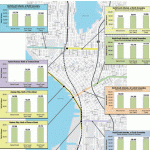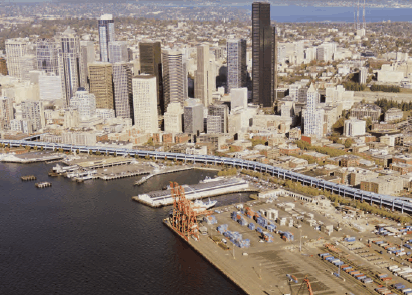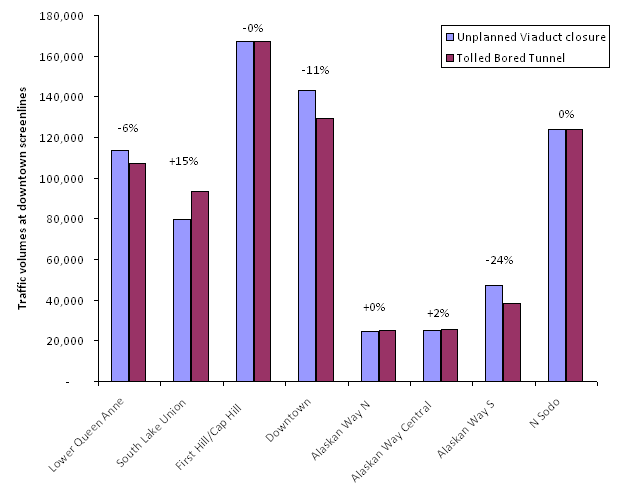The Final Environmental Impact Statement for the Alaskan Way Viaduct replacement project just came out, and it’s a MASSIVE document: 286 pages in the main report, plus a whopping 23 appendices. The transportation discipline report (Appendix C) alone runs to 664 pages. I haven’t actually counted all the pages, but I have to assume that they run into the thousands.
With that much ink devoted to the project, I’m sure that people on all sides of the debate can find tidbits to support their particular point of view. But the tidbits I’m most interested in center on my current obsession: what happens when you toll a single link in a big urban transportation network?
To its credit, the EIS does take a look at how tolling could affect traffic flows on city streets. The results? In a nutshell, the state’s traffic models suggest that, from the perspective of traffic on city streets, the tolled tunnel is only a bit better than an earthquake that closes the Viaduct for good. Here are some numbers, culled from Appendix C:
 As you can see, compared with an earthquake that closes the Viaduct, the state says that the tolled bored tunnel would modestly reduce traffic volumes in lower Queen Anne, on streets in the downtown core, and reduce them a bit more in Alaskan Way through Sodo. But the bored tunnel would make traffic a little worse in South Lake Union. And it’s basically the same as an earthquake for the waterfront, First Hill and Capitol Hill, and traffic crossing between Sodo and the ID/Pioneer Square. (Click on the map to the right for a larger map of where those screenlines are.)
As you can see, compared with an earthquake that closes the Viaduct, the state says that the tolled bored tunnel would modestly reduce traffic volumes in lower Queen Anne, on streets in the downtown core, and reduce them a bit more in Alaskan Way through Sodo. But the bored tunnel would make traffic a little worse in South Lake Union. And it’s basically the same as an earthquake for the waterfront, First Hill and Capitol Hill, and traffic crossing between Sodo and the ID/Pioneer Square. (Click on the map to the right for a larger map of where those screenlines are.)
Other parts of the transportation appendix show that the bored tunnel, with tolls, would reduce total traffic delays by about 6 percent in “Seattle’s Center City,” compared with an earthquake. That’s not nothing, but it’s not a lot either. In fact, in terms of center city traffic delays, the tolled bored tunnel is actually one of the worst performers among the options studied.
Now for the caveats:
First, I have no real opinion about whether the EIS numbers are actually correct. I’ve expressed a lot of skepticism about traffic models in recent months, but most of that skepticism is reserved for the projections of future traffic volumes (the first step of the standard four-step traffic modeling process). I just don’t know how the other steps fare.
Second, the numbers above only cover city streets. I-5 tells a similar story: the state’s models show that tolls on a new SR-99 facility will divert significant amounts of traffic onto I-5. That said, from what I can tell the state models suggest that, in the big picture, a tolled tunnel really is better than an earthquake. Not a whole lot better, but better nonetheless.
Third, the state neglected to model a lower-cost “Streets, Transit, and I-5” alternative. At this point, it’s probably very difficult to match up these model results with the ST5 modeling work that’s already been done. Perhaps some wizard will be able to put that puzzle together. But I suspect that overall traffic performance falls somewhere as it did in previous modeling exercises: that is, with slightly better downtown traffic performance than the tolled tunnel, with much lower cost.
Fourth, all three of the tolled options studied perform about the same on the major EIS metrics. So do all three of the non-tolled options. So the issue isn’t so much with the specific design of the bored tunnel, as with the very idea of putting high tolls on a single link in a larger urban transportation network. High tolls on a single highway seem to divert traffic in ways that wreak havoc on the transportation network.
So if high tolls are creating traffic problems, can’t the state just reduce them, as these folks argue? Unfortunately, I don’t think it’s that easy. The state doesn’t have the money to finish the project without bonding against future toll revenues. So if the state cuts toll rates, it would be forced to pay back the bonds in another way: either by siphoning money away from other projects, or by dipping into the general fund. And seeing that key legislators are adamant about putting Seattle on the hook for any tunnel cost overruns, it strikes me as a major leap of faith to assume that the state legislature would back a bailout on the same project.











Cascadian
Alternatively, if the problem is toll avoidance then a toll that is extended to all downtown corridors would be better wouldn’t it?
What we really need is a congestion charge that both manages demand across the city and also raises money for road construction and maintenance. The same toll across the city could reduce the other taxes for the project and leave more room in the budget for other things, like improving surface streets and providing transit.
Clark Williams-Derry
I agree! A more comprehensive system of congestion charges would also mean that we’d need less road space; we could even pick an amount of road space, and simply manage it using charges. That said, congestion charges raise some tricky equity issues, so you’d have to use the revenue to address those: ie., not just road construction & maintenance but possibly for other worthy goals (transit & housing affordability?)
Will in Seattle
Obviously, we could just impose a Limo and Millionaire Surtax to pay for this boondoggle that we never asked for.
Or … Not build it.
Scott
A little off topic, but could the tunnel as proposed be converted to handle passenger and/or freight trains?
Clark Williams-Derry
Great question. One person I trust suggested that it might be possible to retrofit it into a transit tunnel, much like the downtown bus/Sound Transit tunnel. But I don’t know if the engineering would allow for actual passenger or freight trains.
Wells
Could a carbomb of sufficient explosive force detonated in the DBT take down the Federal Building or any vulnerable building or two or three? I believe Doug Macdonald knows the answer is yes. What I noticed about the EIS is its lack of information regarding the surface/transit/I-5 option. Wsdot is rigging the EIS the same way they rigged previous studies.